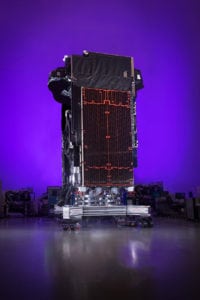Latest News

Boeing is building the ViaSat 3 satellites based on this 702 platform. Photo: Boeing.
ViaSat announced a Public-Private Partnership (PPP) between its subsidiary ViaSat Antenna Systems and the European Space Agency (ESA) to develop key components of the ViaSat 3 satellite communications system with European industry.
ESA kicked off the 68 million euro ($78.9 million) PPP, known as Project Aidan, with an initial 31.2 million euros ($36.2 million). The PPP is co-funded with the support of three ESA member states (Switzerland, the Netherlands and Romania), ViaSat and others within the European industry. This program will focus on developing and productizing two key innovative components of the ViaSat 3 satellite ground segment, which include: fixed and mobile user terminals, including the development of a fully-electronic phased array for residential broadband, in-flight Wi-Fi and connected car applications; and ground segment equipment and gateways for the ViaSat 3 network, which include the Satellite Access Node (SAN) subsystems for a cloud-based ground network infrastructure.
ViaSat 3 is an ultra-high capacity satellite platform, comprised of three ViaSat 3 class satellites and accompanying ground network infrastructure. According to ViaSat, each ViaSat 3 satellite will offer more than 1 Tbps of network capacity. The company expects the platform to give consumers greater choice in their Internet Service Provider (ISP) by enabling 100 Mpbs or higher broadband speeds to the home.
“The PPP with ViaSat will bring ESA and industry together to quickly develop broadband products that will serve the needs of millions of consumers across Europe who are currently without adequate internet service. We believe this is a significant industrial opportunity that will keep Europe at the forefront of satellite and broadband technology development, giving Europe a leading position on the deployment of a next-generation broadband system with advanced ground networks and consumer equipment,” said Magali Vaissiere, ESA director of telecommunications and integrated applications.
Get the latest Via Satellite news!
Subscribe Now